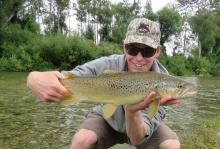Central South Island Reel Life JAN 2017
- 23/01/2017
Summer's here with 'great fishing' on offer
It has been a fickle summer weather-wise, with welcome small but regular rainfall events occurring across the region.
 At this stage last year, we were worried about a drought kicking in and the need to salvage fish from drying sections of lowland rivers was keeping staff on their toes.
At this stage last year, we were worried about a drought kicking in and the need to salvage fish from drying sections of lowland rivers was keeping staff on their toes.
This year it’s not an issue...yet. Let’s hope for more rain.
Above Right: Summer-time fishing on the lower Opihi River.
Summer river flows have set in however, and the usual algal growth is a feature of some stretches of river but surprisingly absent in others.
There's excellent fishing action to be had, especially on the dry fly.
As river flows decrease, the amount of good holding water reduces.
For the angler the real benefit from this is that trout congregate in the best water.
Don’t be surprised if you find two to ten large trout in the best pools in lowland rivers like the Opihi.
Dry flies like Parachute Adams, elk hair caddis and black gnat are worth a try, and soon cicada should announced their presence with a chirp befitting an alarm clock.
The great thing about dry flies too is they won’t catch the pesky algal growth like nymphs.
But sometimes a nymph must be used so try #16 or #18 weighted and non-weighted pheasant tail and hare and copper variations for a start.
Spin fishing and bait fishing in lowland rivers can be tough in summer as trout become a bit wary of an angler's offering.
Any rise in flow due to rain should be pounced on, as the fish will often feed more aggressively with the increase in flow delivering more food items faster in the drift.
Low light times like dawn and dusk are recommended too.
The Waitaki River, high-country lakes and the Mackenzie basin canals provide better spin and bait fishing options through the heat of summer.
Sea-run salmon?
It has been a slow start to the sea-run salmon season but a small number have been caught at our three most consistent salmon fisheries: the Rangitata, Waitaki and Opihi rivers.
Staff have heard little news of any salmon action at the Orari River mouth.
February and March are the best months for salmon fishing so we wait in eager anticipation to see what runs.
The Rangitata flows have been up and down and there's been only a few short periods with ideal fishing conditions.
For this reason there is likely to be a small number of fish throughout the length of the river that have snuck past the anglers.
The Opihi River mouth has closed for a few short periods this summer and has subsequently been mechanically opened by ECan to prevent flooding of paddocks, campsites and the hut settlement in the lagoon area.
Upper Ahuriri angler survey
Have you fished the upper Ahuriri River and associated lagoons and tarns upstream of Longslip Creek (Birchwood Rd turnoff) this year? If so, we would like to hear about your day!
An online version of our upper Ahuriri angler satisfaction survey can be filled in following your days fishing by visiting our website, click here.
Left: The Ahuriri valley looking downstream towards the Ireland Road Bridge.
We plan to use this information to maintain the satisfaction of anglers who visit the area for the high quality back country fishing on offer.
Spawning habitat probed
Fish & Game Central South Island and North Canterbury have finished up a three year project to intensively monitor salmon spawning habitat in some of Canterbury’s most significant salmon spawning streams.
The project was in collaboration with Environment Canterbury (ECan).
Water, stream bed habitat, and invertebrate samples were collected by Fish & Game and ECan staff.
Right: Fish & Game Officer Hamish Stevens collecting invertebrate samples from Black Mountain Stream.
ECan’s ecologists are now tasked with compiling three years of monthly monitoring data.
In the Central South Island Region the project focused on the upper Rangitata tributaries: Deep Creek, Deep Stream and Black Mountain Stream.
The project results will provide a baseline of current habitat quality, which can be re-measured in future to evaluate if any changes have occurred.